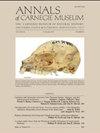褐鼠,Rattus norvegicus (Berkenhout, 1769)的岩耳和中耳解剖(啮齿目,鼠科)
IF 0.9
4区 地球科学
Q4 PALEONTOLOGY
引用次数: 17
摘要
摘要本文描述了褐鼠褐家鼠(Rattus norvegicus, Berkenhout, 1769)的岩石和相关中耳结构的解剖结构。虽然这种标志性哺乳动物的中耳已经被先前的作者处理过,但使用当前的解剖学术语还没有一个全面的,很好的说明贡献。描述基于哺乳动物部分的骨骼标本,卡内基自然历史博物馆,以及德克萨斯州纪念博物馆的CT扫描骨骼标本。从CT扫描中分离出岩骨、外鼓室、锤骨、砧骨、镫骨和内耳。棕色大鼠的岩骨只松散地附着在头盖骨上,主要沿着它的后缘;它由一个大梨状窗与基蝶骨、阿利蝶骨和鳞状肌分开,梨状窗传递包括盂后静脉在内的各种神经血管结构。梨状孔的范围在侧面广泛地暴露出岩膜的鼓膜。中耳的底是由扩张的外鼓室球组成的,外鼓室球通过五个接触点紧紧地与耳石相连。与外鼓室球接触的岩石表面是吻侧鼓室突、上鼓室翼、鼓室被盖、尾侧鼓室突三个部分中的两个部分和鼓膜,其中外鼓膜融合到最后。外鼓室又与锤骨的长吻突融合在一起,这只有通过对幼年标本的研究才能发现。除了骨学,主要的神经,动脉和静脉岩的描述和说明基于文献和骨相关。将棕鼠的岩质与几种始新世啮齿类动物的岩质进行比较,以便将现存的岩质形式置于啮齿动物谱系早期成员的背景中。来自美国西部的1871年始新世中期等色肌样Paramys delicatus Leidy的CT扫描提供了始新世啮齿动物岩石颅内表面的第一个描述。始新世化石中的岩质更紧密地附着在头盖骨中,但外鼓室通过同样的五个点与岩质接触,只是有一些变化。最意想不到的发现是,在与减少的岩嵴接触的顶骨上有一个突出的幕状突起。本文章由计算机程序翻译,如有差异,请以英文原文为准。
Anatomy of the Petrosal and Middle Ear of the Brown Rat, Rattus norvegicus (Berkenhout, 1769) (Rodentia, Muridae)
ABSTRACT The anatomy of the petrosal and associated middle ear structures are described and illustrated for the brown rat, Rattus norvegicus (Berkenhout, 1769). Although the middle ear in this iconic mammal has been treated by prior authors, there has not been a comprehensive, well-illustrated contribution using current anatomical terminology. Descriptions are based on specimens from the osteological collections of the Section of Mammals, Carnegie Museum of Natural History, and a CT scanned osteological specimen from the Texas Memorial Museum. The petrosal, ectotympanic, malleus, incus, stapes, and inner ear were segmented from the CT scans. The petrosal of the brown rat is only loosely attached to the cranium, primarily along its posterior border; it is separated from the basisphenoid, alisphenoid, and squamosal by a large piriform fenestra that transmits various neurovascular structures including the postglenoid vein. The extent of the piriform fenestra broadly exposes the tegmen tympani of the petrosal in lateral view. The floor of the middle ear is formed by the expanded ectotympanic bulla, which is tightly held to the petrosal with five points of contact. The surfaces of the petrosal affording contact with the ectotympanic bulla are the rostral tympanic process, the epitympanic wing, the tegmen tympani, two of the three parts of the caudal tympanic process, and the tympanohyal, with the ectotympanic fused to the last. The ectotympanic in turn is fused to the elongate rostral process of the malleus, which is only discoverable through the study of juvenile specimens. In addition to osteology, the major nerves, arteries, and veins of the petrosal are described and illustrated based on the literature and osteological correlates. The petrosal of the brown rat is compared with those of several Eocene rodents to put the extant form in the context of early members of the rodent lineage. Comparisons benefitted from CT scans of the middle Eocene ischromyoid Paramys delicatus Leidy, 1871, from the western United States, affording the first description of the endocranial surface of the petrosal in an Eocene rodent. The petrosals in the Eocene fossils are more tightly held in the cranium, but the ectotympanic contacts the petrosal through the same five points, with some modifications. The most unexpected discovery in Paramys delicatus was the presence of a prominent tentorial process of the parietal in contact with the reduced crista petrosa.
求助全文
通过发布文献求助,成功后即可免费获取论文全文。
去求助
来源期刊

Annals of Carnegie Museum
综合性期刊-动物学
CiteScore
2.50
自引率
18.20%
发文量
4
审稿时长
>12 weeks
期刊介绍:
Annals of Carnegie Museum is a quarterly journal that publishes peer-reviewed short and medium-length original scientific contributions in organismal biology, earth sciences, and anthropology, in 40 by 52.5 pica format (168 by 220 mm or 6-5/8 by 8-5/8 inches). Subject matter must be relevant to Carnegie Museum of Natural History scientific sections or Powdermill Nature Reserve (PNR), preferably with connection to the Carnegie collection and/or personnel. Carnegie Museum staff and research associates receive publication priority, but others are encouraged to submit papers, especially those manuscripts explicitly based on the Carnegie collection.
 求助内容:
求助内容: 应助结果提醒方式:
应助结果提醒方式:


